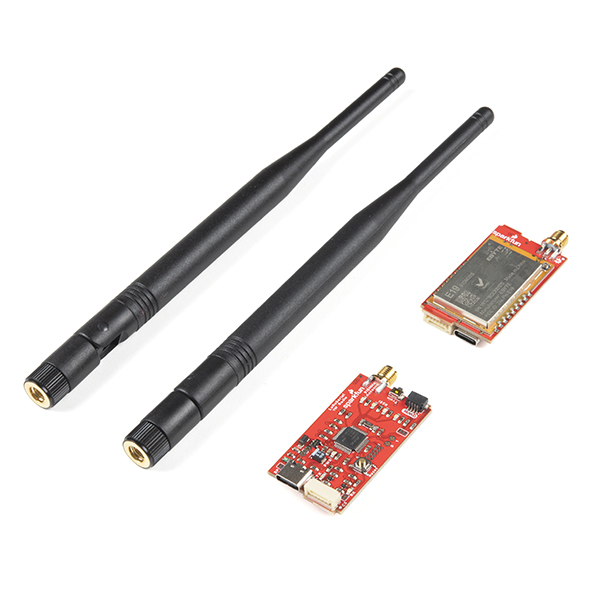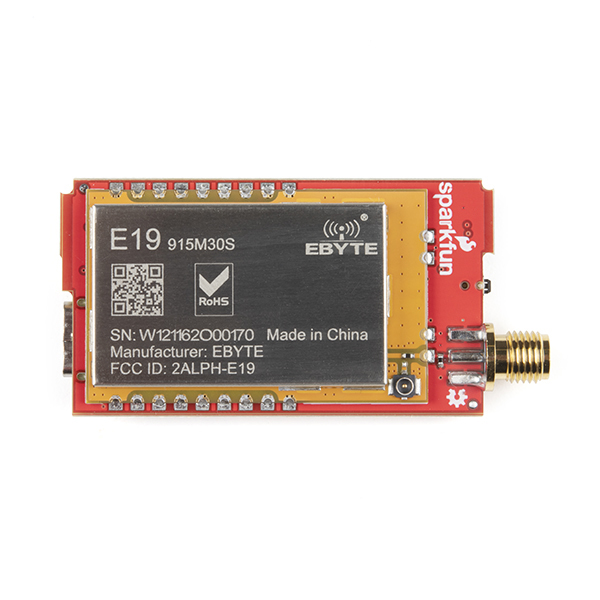SparkFun LoRaSerial Kit - 915MHz
LoRaSerial is a pair of serial radio modems that simply passes serial back and forth. Do you have a system that needs to report data every few seconds? Is it located beyond WiFi or Bluetooth® range? Do you need 9 mile/15 kilometer range? LoRaSerial transmits data over LoRa giving it incredible range compared to other methods. We’ve regularly transmitted over 9 miles/15km line-of-sight using two LoRaSerial radios, right out of the box.
LoRaSerial utilizes a 1 watt 915MHz transceiver and an open source protocol to and transmit AES encrypted data at 4800bps or approximately 480 bytes per second. Video streaming, this is not. LoRaSerial is very good at getting whatever data you need from point A to point B, encrypted, without configuration. The radios automatically frequency hop (FHSS) between channels to avoid collisions. The ‘airspeed’ or data rate is configurable up to approximately 3,000 bytes per second for shorter range, or for extremely long range transmissions, as low as 4 bytes per second. LoRaSerial radios support simple point to point and point as well as multipoint broadcasts. Multipoint broadcasting makes it ideal for GNSS RTK and many other scenarios where one device needs to produce data and many devices need to consume that data.
The LoRaSerial firmware supports an innovative and simple to use ‘training’ method. Pressing the train button on both radios will generate a new random network ID and AES encryption key and share them between radios. This makes pairing radios in the field as simple as a button press. WiFi WPS this is not. Bring the radios near each other and the LoRaSerial training method is simple and secure.
Serial can be interfaced over TTL serial (cables included) or over a USB C connection. This allows serial transmission from desktop computers, single board computers, embedded systems, etc.
Currently SparkFun is offering radios utilizing 915MHz modems that are allowed in most parts of the world. Please check your local restrictions. The radios are fully configurable to restrict frequencies, channels, dwell time, power output, and a variety of other settings to make the radios compatible with your local regulations.
Note: LoRaSerial is designed to operate at the physical layer of LoRa sending data directly to an end point as opposed to something like LoRaWAN that operates on the data and network layers. For this reason LoRaSerial is not intended to operate on LoRaWAN.
Please be aware: This product is currently in the beta phase and is discounted accordingly. This version is recommended for users who are willing and able to provide feedback and update the firmware as new features are made available. The radios work but may not be ideal for all applications yet.
- 2x LoRaSerial Radios with 915MHz LoRa module
- 2x 915MHz 1/2 Wave 2dBi antennas
- 2x Serial interface cables
- 1 Watt (30dBm) power output
- 915MHz unlicensed band radio with 902-928MHz configurable output
- 256 bit AES GCM encryption
- Simple AT command set
- Built-in Frequency Hopping Spread Spectrum (FHSS) technology
- Configurable air speeds from 40 bps (4 bytes per second) to 40kbps (4,000 bytes per second)
- Configurable standard serial data rates from 2400 to 115200bps
- 4-LED RSSI Indicator
- 3.3 to 5V operation
- USB C connection available for industrial systems and single board computers (SBCs like Raspberry Pi)
- 6-pin JST connector available for embedded systems (5V and 3.3V tolerant I/O) with flow control
- Schematic
- Eagle Files
- Repo including hardware files and firmware
- SX1276 Datasheet
- E19-915M30S Datasheet
- Understanding LoRa PHY - A good article on the math behind Semtec's Long Range modulation technique
SparkFun LoRaSerial Kit - 915MHz Product Help and Resources
Comments
Looking for answers to technical questions?
We welcome your comments and suggestions below. However, if you are looking for solutions to technical questions please see our Technical Assistance page.
Customer Reviews
No reviews yet.





can i use this radios with the rtk facet?
Yep - the LoRaSerial is designed to work with short data bursts such at RTCM correction data needed between two RTK devices.
On the legality of this radio in the US:
Unlicensed operation on the 915 MHz ISM band has a power limit of -1.23 dBm EIRP (Effective Isotropic Radiated Power; that's less than 500 microwatts) if used on a single frequency. Higher power is allowed for spread spectrum operation; the limit increases to +30 dBm EIRP (1 watt) for frequency hopping on 50 channels or fewer, or +36 dBm EIRP (4 watts) if more than 50 channels are used. +36 dBm EIRP is also allowed for digital spread spectrum.
This kit comes with antennas with gain of +2 dBi and transmits at 1 watt (+30 dBm), and thus the EIRP of the transmitter is +32 dBm. It can be legally used if more than 50 channels of frequency hopping are used, but not if the number of channels is 50 or fewer. The provided antennas are omnidirectional in the horizontal plane if positioned vertically, but not in the vertical plane; there will be little radiation along the line of the antenna. It could be upgraded with antennas with up to +6 dBi gain if more range is desired; that might require aiming of the antennas.
Licensed amateur radio operators can use much more power on the 915 MHz band if the requirements for identification are fulfilled, all the way up to the legal maximum of 1500 watts (+62 dBm) with no restrictions on antenna gain. Encryption is not allowed on amateur radio, so using the AES encryption would be illegal. Spread spectrum on amateur radio requires the use of a publicly available spread algorithm so it does not constitute a form of encryption. (Examples: the direct sequence spread spectrum used in the 802.11b WiFi standard is published and therefore legal. The spread spectrum method used in CDMA cellular telephone service is illegal because it is an unpublished and proprietary algorithm that is based on the MAC address of the device.)
Source for information about the power limits: https://www.digikey.com/en/articles/unlicensed-915-mhz-band-fits-many-applications-and-allows-higher-transmit-power
Outside the US the rules are more restrictive; you are likely to have to constrain this radio to a smaller range of frequencies if you can use it at all. The entire range of 902 to 928 MHz is only available in ITU Region 2 (the Americas), with some exceptions (notably Brazil). The EU has now made the range from 915 to 921 MHz available for ISM devices, including LoRa radios; check the regulations in your country to make sure this kit is compliant. (You will be required to cease operation if you cause interference to the nearby 900 MHz cellular band.) Many nations in Asia have made some frequencies in this range available; for example, Singapore allows the use of 920 to 925 MHz. Power limits also vary, so you might have to reduce the output power of the radio or use antennas with less gain.
Thank you for this information. I am a registered ham radio operator (KO4TCY) in the US. So, I believe that I should be fine using this radio at 1 watt with a high gain antenna (5.8 dbi gain in my case). I am a little confused as to how to identify using these radios as they are data radios.
Hi Shirley - Thanks for weighing in. I appreciate the links to digikey, and your thoughts. Please continue to add source links.
What's your source for this statement? All of my research pegged this at 'at least 50', not 'more than 50'. FCC Docket 96-8, FCC Part 15 ISM Regulations by Raveon, among others. This is why the default is 50 channels off the shelf, but if a certain area or application needs more, ATS10=51 will get you what you need. See the hookup guide for more info on the command set.
The LoRaSerial is FHSS by default so max EIRP is 36dBm. We are well within that limit and, using the default settings, are legal within the USA.
This product is 915MHz center band and is primarily intended for North America. We have other versions coming for 868 and 433MHz for other countries.
I encourage the dialog. The FCC rules are dense and I am far from an expert but we have leaned heavily on our friends at various ATLs to make sure we don't stray too far into bad territory.